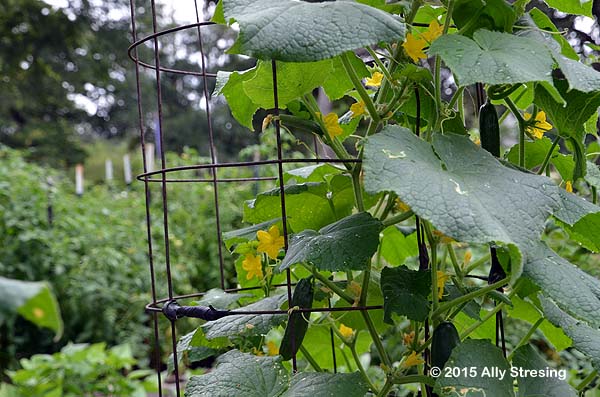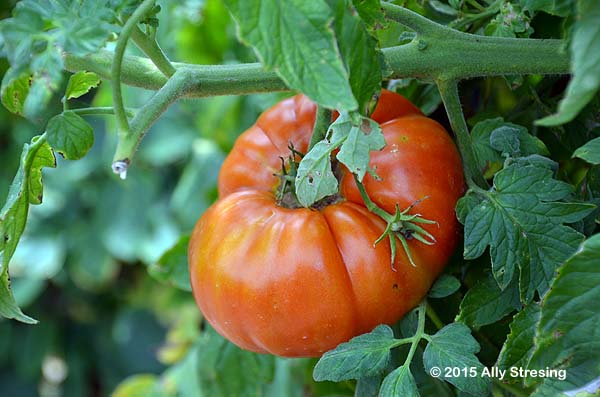For years my mulch of choice for the vegetable garden was alfalfa hay. Alfalfa is what Ruth Stout recommended and if it was good enough for Ruth, it was good enough for me.
When alfalfa got too expensive, I sometimes used coastal hay. Then, the drought hit and even coastal hay got crazy expensive. Still, I never really thought of mulching with anything else. Hay worked...until it didn't.
Last fall I started having problems with these little beasties.
I couldn't seem to grow anything from seed. The seedlings would come up, but then slowly but surely rows of my new seedlings would disappear. I thought maybe it was cut worms, but I couldn't find any evidence.
Finally, in the spring the cause of the problem became obvious. The pill bugs had reached epic proportions. They were visibly crawling over everything and eating my plants with wild abandon.
The pill bugs were munching on everything and anything. I couldn't sow bean seeds because the pill bugs would mow them down. They even ate my basil!
I tried diatomaceous earth and Sluggo Plus. The Sluggo worked pretty well, but the rain would wash it away and the pill bugs would return with a vengeance. I also tried trapping the pill bugs with watermelon rinds, rolled up newspaper, and pie tins full of beer, but those rascally creatures would not be deterred. There were just too many and their numbers were growing.
One day, I was talking to some fellow gardeners and someone asked if I had tried using pine straw instead of hay. Apparently, pills bugs love to break down hay, but aren't so fond of pine needles.
I figured it was worth a try, so I purchased 6 bales of pine straw at $6.95 a bale. It didn't stretch very far, but overall it probably isn't anymore expensive than using hay. I liked the look of the pine needles in the garden and decided to mulch the entire space with the pine needles after finding a free source in Bastrop.
By the way, when I went to rake up the free needles, I asked the homeowner if she had problems with pill bugs. She said, no, and sure enough I didn't see any pill bugs while I was at her house.
This is all purely anecdotal, but I have to say the pine needles are working. I have noticed a marked decrease in pill bug activity in the vegetable garden, but I'm still seeing them in other areas of the yard where I'm not using the pine needles.
I never expected pill bugs to become such a nuisance. Hopefully, the pine straw is the answer, but if not, at least the garden is piney fresh.
One tomato, two tomato, three tomato four... the Sun City Organic Gardeners sure know how to grow some tomatoes! From the moment my group entered the gate with member gardener, Richard Bucho, we couldn't stop oohing and aahing over all the tomatoes.
Our first stop was to chat with another member who was heading home with his bag of garden goodies. He encouraged us all to share in his bounty, so we lightened his load and thanked him kindly. You know it's going to be a good tour when you're offered free tomatoes!
Tomatoes are certainly king of the summer garden. Just look at these beauties!
There were lots of gorgeous tomatoes, but none compared with this diminutive beauty. Blue indigo cherry tomato is on my future plant list!
All of this swooning over garden fresh tomatoes caused me to get a little ahead of myself. Let me start at the beginning.
I was recently invited to tour the Sun City Organic Garden in Georgetown by fellow gardener, Richard Bucho. During a subsequent phone interview with Randall Brown, the Horticulture Club President, I learned that the community garden has 265 garden plots. Most plots are 4 by 25 foot raised beds and each bed has it's own water spigot, which is a very nice feature.
Membership is $25 per year and includes water, tools, horse manure, sand and crushed granite. What a deal!
A one time fee of $225 is assessed on new members. According to Randall, the one time fee initially paid for all the cinder blocks used to construct the beds, but is now used for improvements such as their fabulous barn and water collection system.
Two 2,500 gallon water tanks collect water from the barn roof, while a third tank collects water from the greenhouse.
The open air tool shed behind the barn is totally amazing! Pretty incredible, right! Any garden with this many shovels surely means business.
Don't forget to cleanup at this adorable sink wagon. I want one!
This garden is huge and we had a great time winding our way up and down the isles checking out what everyone was growing.
I was amazed by the productivity of this garden. Many plants were dripping with produce of all kinds. Five of the beds in this garden are dedicated to growing food for Caring Place and the Annunciation Maternity Home. Members are encouraged to donate excess produce as well.
 |
| Tomatillo |
 |
| Cucumbers |
 |
| Gourds |
 |
| Okra |
 |
| Cantaloupe |
 |
| Jalepeno Peppers |
 |
| Corn and Sunflowers |
What garden would not be complete without a greenhouse! According to Randall, the Sun City Organic Garden horticultural club grows many of the plants featured in this garden. The club hosts two plant sales a year and grows thousands of seedlings as well as perennials. The next sale scheduled for Saturday, September 26, 2015, will feature fall vegetable transplants, irises and other perennials. Sounds good to me!
One of the big surprises in the garden, other than the shear size, was the community orchard and vineyard. Plums, peaches, figs and persimmons were some of the fruit trees I saw. The vineyard was being meticulously tended by a member who told me they were growing a red wine grape variety called Norton.
 |
| Plums |
 |
| Peaches |
 |
| Figs |
 |
| Persimmons |
 |
| Norton Grapes |
 |
| Vineyard |
The Sun City Organic Garden has extensive perennial beds for those members who are interested in growing flowers.
Flowers invite bees and other pollinators to the garden and create a diverse environment that greatly benefits the vegetables that are growing nearby.
 |
| Lantana |
 |
| Gregg's Mist Flower |
It's not all work at the Sun City Organic Garden. I noticed several seating areas scattered through out the garden inviting members to sit a spell.
Here's my host, Richard, kicking back for a quick photo op.
I'd like to thank Richard for this fabulous tour. Also, thanks to Randall for his phone interview. You've got a real gem there in Georgetown. I'm grateful that you shared your time and garden with me.














































